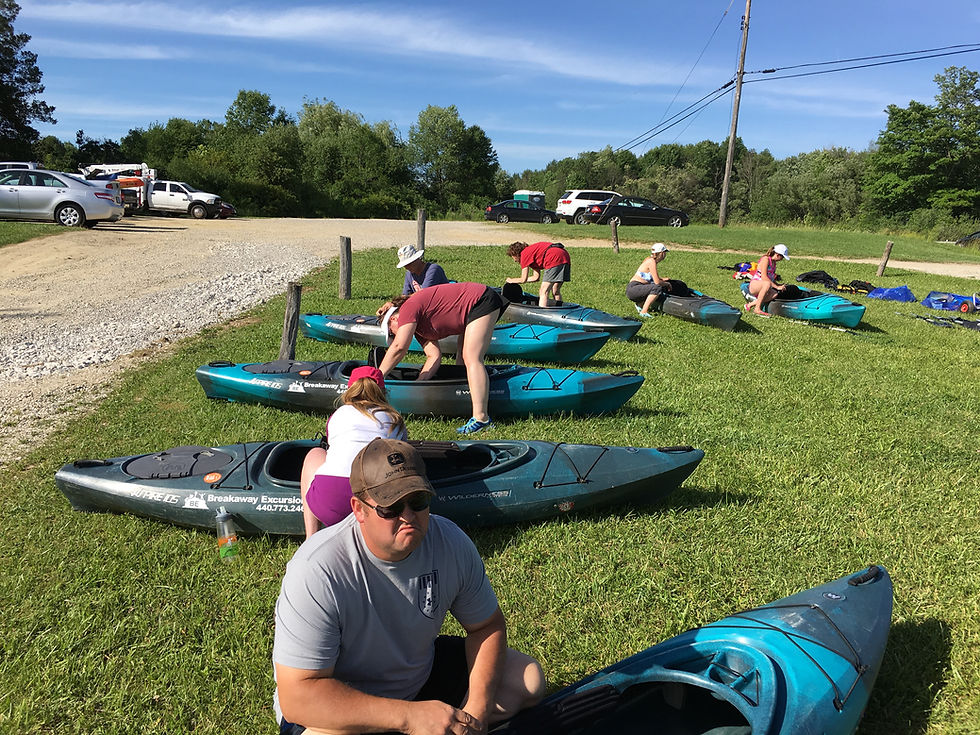
What a great night for a beginner kayaking class. The weather was absolutely beautiful. Not too hot and not too cold. Just right.
I would like to thank everyone who came out for this class. You did an amazing job. I was very impressed with how quickly everyone in the group grasped the concepts and mastered the techniques.

The first 1.5 hours was the beginner class. We learned the differences between performance boats and recreational boats. We looked at a sea kayak and compared it to a whitewater kayak. It was pretty obvious why a person would want a smaller boat for whitewater and a longer sleeker boat for sea kayaking. We also pointed out that performance boats have smaller cockpits and a tighter fit on the hips. This improves performance on rough waters. It also requires a person to master a technique known as a wet exit in order to get out of the boat. Please contact us if you are thinking of buying a performance boat and we can set up a one on one session to teach you how to wet exit if your boat capsizes.
We used our Wilderness System Aspire 105 rental kayaks for our class. This kayak is considered more of an intermediate recreational boat. It has the stability of a normal recreation boat, but it also handles well on gentle moving water.
Recreation boats generally have larger cockpit openings and more primary stability than performance boats. The design allows for the paddler to be able to fall out of the boat should the boat flip over. You do not need to master the wet exit technique in order to paddle them.
Beginner Class:
During the class we learned a variety of beginner strokes and introduced a few more advanced strokes. Everyone mastered the forward stroke, the reverse stroke, the forward and reverse sweeps. Sweeps are used for turning the boat while forward and reverse strokes are used for moving in a straight line.
We also earned how to rudder on the left and right side of the boat. This is a simple technique used to make small corrections when we have forward momentum and want to make small changes in direction we are traveling. In addition, we threw in a J-lean which assists us with our rudder techniques.
Since the class was doing so well, we introduced a more advance technique known as the high brace. This is a great technique used to upright a kayak which may be tipping to far to one side or the other. This is very useful when one accidentally runs up on top of a log or rock and finds ourselves off balance. It's also helpful to master this technique before moving into whitewater or sea kayaking.

Self-Rescue Kayaking Class:
Four of our clients who paddled in the beginner class also signed up for our Self-Rescue Class. This was a great group of individuals who range in age from their early 20's to the 70's. Awesome job to everyone who participated.
During the class we practiced falling out of our boat, and more importantly, how to get back in. We did team rescue using a second and third person to help a swamped paddler back into their boats. We used the boat over boat technique to empty the water out of the victims boat and the cowboy method for getting back into the boat with support from another boater. We also learned how to get back into a boat by yourself when you have capsized your boat. For this method we used a paddle float to give us leverage for getting into the boat.

Jared, our new (young and athletic) instructor also demonstrated the cowboy method for getting back into a kayak without any aids or props. One of our clients was actually able to perform that technique unassisted. Kudos to you young lady.

In addition to re-entry techniques we also learned how to use a bilge pump for pumping excess water out of a boat. And we learned how to plow another boat to shore using the bow of our boat and how to stern tow a victim back to shore using the back of our boats.
It was a great night of learning and paddling on the open water. I would feel comfortable renting any of our kayaks to these individuals. They all did a fabulous job and showed that they understand the basics of kayaking and the safety needed for it.
Welcome our new paddlers to our kayak community.












